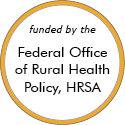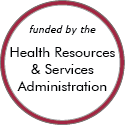Rural Project Examples: Healthcare needs and services
Promising Examples
Nurse Navigator and Recovery Specialist Outreach Program

Updated/reviewed December 2025
- Need: To properly address and treat patients who have concurrent substance use disorders and chronic healthcare issues.
- Intervention: A referral system utilizes community health workers (CHWs) in a drug and alcohol treatment setting. A registered nurse helps with providers' medication-assisted treatment programs.
- Results: This program has reduced hospital emergency visits and hospital readmissions for patients since its inception.
The Rural Virtual Infusion Program

Updated/reviewed November 2025
- Need: Allow rural cancer patients in a region inclusive of 26 counties in Iowa, Minnesota, and South Dakota to have access to tertiary-level chemotherapy regimens administered in rural infusion centers.
- Intervention: With telehealth-based oversight from a tertiary care oncology team, 3 rural infusion teams were trained to coordinate cancer treatment plans and administer complex chemotherapy regimens.
- Results: The original grant-supported effort — with its results of saving130 patients 65,000 trip miles and 1,800 travel hours – proved sustainable.
Communities that Care Coalition
Updated/reviewed September 2025
- Need: To improve the health and well-being of young people in the rural area of Massachusetts's Franklin County and North Quabbin, and to reduce youth drug and alcohol use.
- Intervention: A community-based prevention coalition was formed to improve youth health and well-being and reduce youth drug and alcohol use. The coalition brings together stakeholders from across the community and uses the Communities That Care evidence-based community planning system.
- Results: CTC has seen significant reductions in substance abuse among local youth in the 30 rural towns they serve.
Schools That Care

Updated/reviewed September 2025
- Need: To provide mental health services to rural Kansas students and their families.
- Intervention: The Schools That Care project provides mental health treatment and case management as well as community education events.
- Results: From 2018 to 2021, 3,456 individuals participated in health education and counseling activities offered to the public, and 964 individuals and 303 families received direct services through the Family Advocate.
TelePrEP
Updated/reviewed May 2025
- Need: To prevent new cases of HIV in rural Iowa.
- Intervention: TelePrEP provides preventive care via telehealth and prescription delivery.
- Results: Between February 2017 and August 2020, TelePrEP received 456 referrals, with 403 patients completing an initial visit.
SASH® (Support and Services at Home)
Updated/reviewed April 2025
- Need: In Vermont, the growing population of older adults, coupled with a lack of a decentralized, home-based system of care management, poses significant challenges for those who want to remain living independently at home.
- Intervention: SASH® (Support and Services at Home), based in affordable housing and their surrounding communities throughout the state, works with community partners to help older adults and people with disabilities receive the care they need so they can continue living safely at home.
- Results: Compared to their non-SASH peers, SASH participants have been documented to have better health outcomes, including fewer falls, lower rates of hospitalizations, fewer emergency room visits, and lower Medicare and Medicaid expenditures.
Health without Borders


Updated/reviewed January 2025
- Need: To improve the health of communities in the south central region of New Mexico.
- Intervention: A program was developed to address diabetes prevention and control, behavioral healthcare, and immunization in Luna County.
- Results: During the program, 1,500 immunizations were distributed, baseline measurements of participants improved, and 935 new patients were seen for behavioral health issues.
Arkansas Rural Health Partnership Hospital-based Transitional Care Program

Added July 2024
- Need: Solutions for Medicare beneficiaries' post-acute care recovery gaps in Arkansas's southeast Delta Region.
- Intervention: Supported by federal funding and their membership organization, seven hospitals implemented an evidence-supported Critical Access Hospital transitional care model.
- Results: Participating hospitals found a significant increase in swing bed services revenue, an all-cause low readmission rate, high percentage of patients discharged to home or to an assisted living environment, and positive patient satisfaction surveys.
Cross-Walk: Integrating Behavioral Health and Primary Care

Updated/reviewed May 2024
- Need: To address and treat substance use disorder (SUD) and depression in the Upper Great Lakes region.
- Intervention: Cross-Walk, a program that integrates behavioral healthcare into primary care services, was developed in Michigan's Marquette County.
- Results: The collaborative efforts strengthened care management services in local healthcare facilities as primary care patients were referred to a behavioral health specialist.
Healthy Connections, Inc. Healthy Families Arkansas

Updated/reviewed December 2022
- Need: High poverty rates and lack of access to healthcare make caring for unborn and newborn children difficult for young mothers in Arkansas's Polk and Garland Counties.
- Intervention: An Arkansas-based program provides a national healthcare service to expectant and young mothers. Prenatal check-ups, education, transportation, well-baby checks and child immunizations are all provided by the Healthy Connections, Inc.
- Results: The program's results demonstrate an increase in first trimester prenatal care rates and child immunization rates, as well as a dramatic decrease in confirmed cases of child abuse.
For examples from other sources, see:
